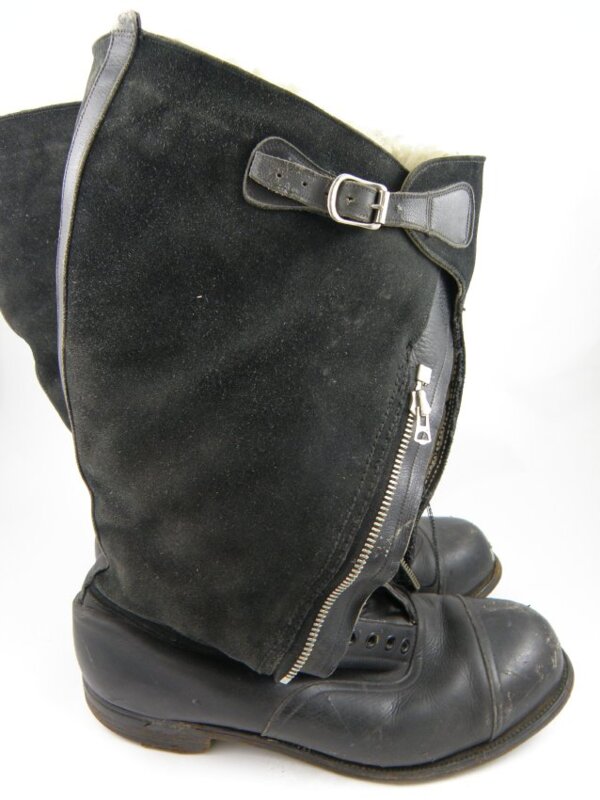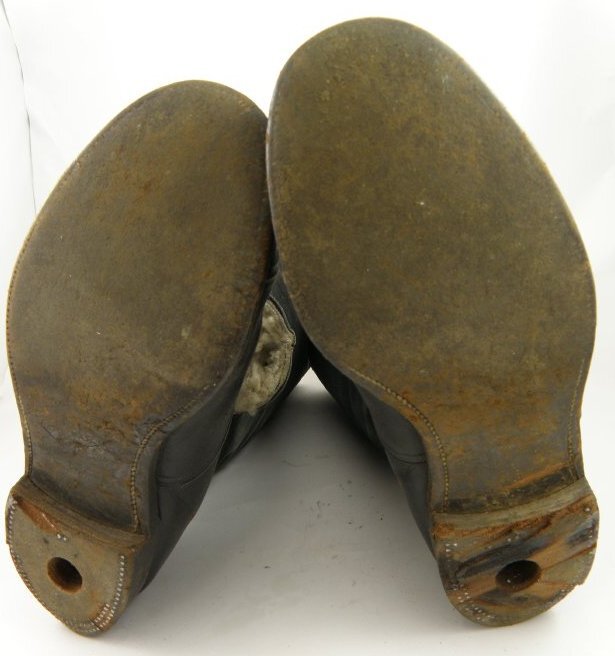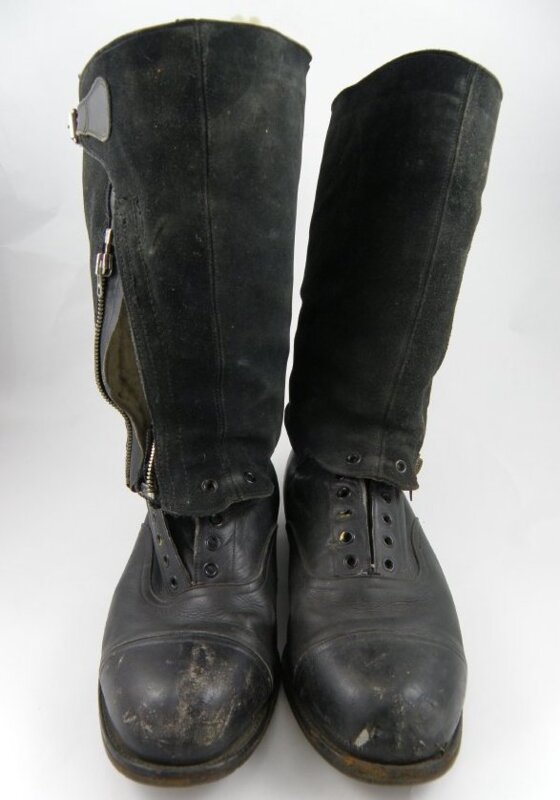Escape/Flying Boots
Item
Title
Escape/Flying Boots
Description
RAF 1943 PATTERN ESCAPE/FLYING BOOTS Black suede fourteen inch tall boot which is fastened by a vertical eight inch brass zipper stamped with a Broad Arrow which zips from the top to the bottom . Above the zipper at the top of the throat is a single leather buckle strap which fastens to a plain metal buckle. The inner lining is comprised of wool shearling with a small rectangular pocket sewn into the lining and located near the inner top of the boot which is meant to hold a retactable pen knife(not present). A black leather civilian style shoe with ten painted black metal eyelets is sewn to the base of the suede boot throat. The black laces with magnetic ends are not present. The smooth stitched leather soles have one inch stacked leather heels which are attached by hob nails.
Date
Identifier
009.500.080
Medium
Provenance
1st pattern ‘prototype’ RAF Escape Boots, designed by Clayton Hutton of MI-9 and produced in 1942. They differ from the pattern eventually adopted for general issue in 1943 having the zip to the front rather than the side, and smooth leather rather than suede uppers. Size stamped on the sole and inner leather tabs. The uppers were designed to be cut away by knife, leaving a pair of shoes of civilian appearance which would not hinder the wearers escape attempt. Escape Boots (c. 1943-45, England, MI9 issue) These boots were designed for British pilots during WWII by MI9, an organization that provided escape and evasion equipment to the Royal Air Force. The bootstrap concealed a small pen knife used to cut off the tops of the boots, making them appear to be civilian walking shoes. A pilot would have been easily spotted because of his distinctive “flying boots.” The converted shoes helped him blend in with the civilian population aiding his escape from enemy territory. The 1943 Pattern escape boot was designed in response to reports received from returned airmen who had baled out over occupied Europe and managed to make their way back to England. The men reported that when on the run from the Germans, their flying boots had a number of problems. The most significant were that they were highly conspicuous when trying to blend in with the local population and that they became heavy and waterlogged if the boots got wet. This prototype escape boot was one of the pieces of escape and evasion equipment designed by Hutton featured in a February 1942 publication ‘Per Ardua Libertas’, published for the benefit of visiting American intelligence officers). Hutton worked at MI9 designing escape aids for issue to service personnel, or to be smuggled into prisoner of war camps. Some airmen undertaking missions over Europe in 1942 were issued the prototype boots. The boots were successful and went into production. Some versions of the 1943 Pattern boot contained gigli saws hidden in the shoe laces. Gigli saws are used by surgeons to cut through bone. They are made from special steel wire, are very pliable and could be hidden inside the laces. Once removed from the lace and held at the right tension, the gigli saw could cut through very hard substances. The boots also had magnetised metal shoe lace ends that could be used as bar compasses. In other versions, the knives were held in the heel. In some boots even more items, such as maps or money, could be hidden in a secret compartment in the heel. Before the introduction of the 1943 Pattern boot, airmen wore a variety of boot designs. It was replaced by the 1939 Pattern, which was similar in style, but had a vulcanised fabric leg. Many airmen must have found the 1936 Pattern boot relatively comfortable as the boots continued to be worn, long after other pattern boots had been issued. However, neither pattern had enough room to easily allow the legs of the flying suit to be tucked into the boots. In addition, the vulcanised rubber of the 1939 Pattern boot did not repel dew from grass along runways. This water could then freeze while flying at high altitudes, so a new pattern was designed. The new design was the 1940 Pattern boot issued in 1941. These boots were looser and allowed for the flying suit legs to be tucked in, however this led to another problem - they often came off when baling out of planes! To alleviate this problem the 1941 Pattern boot was then issued - essentially the 1940 Pattern boot with the addition of a leather strap that could be tightened around the ankle (below) to help keep the boots on when baling out. The 1943 Pattern escape boot was the last boot designed and issued during the war. Despite the advantages of this boot when evading capture in occupied Europe, some airmen found them to be uncomfortable when flying and preferred to wear their older issue boots.






